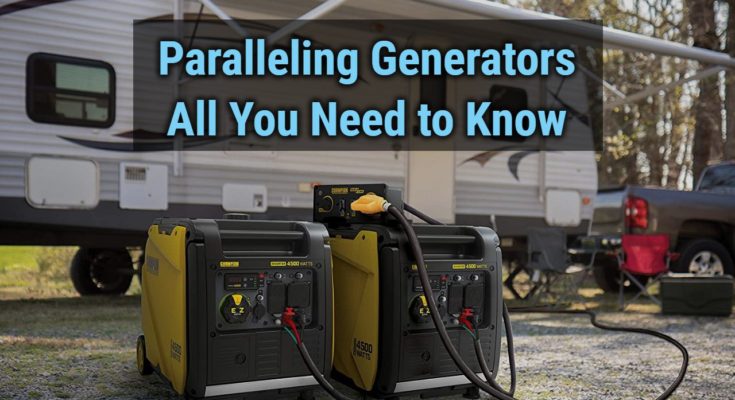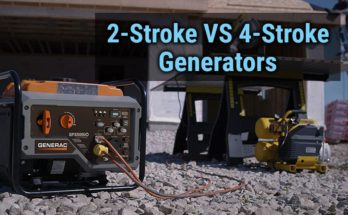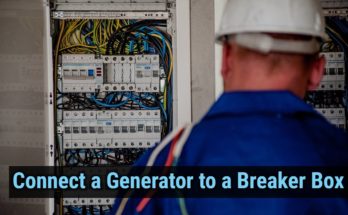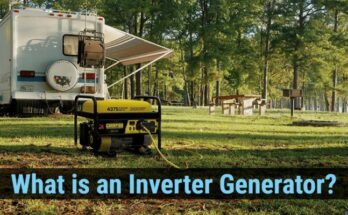Generators are essential during the blackout, and it keeps all the important appliances running. There are many types of generators with varying sizes. Any mid to small size generator can satisfactorily power many appliances in the house. But when the power need increases and one generator is not enough, you can buy another same size generator with the parallel capability and can connect them together.
This not only increases the power output but also offers many other advantages. When you don’t need the high power, one can be disconnected, and one will supply power. Also, their smaller size provides increased portability; thus, you can take it for camping or tailgating. To make the parallel connection is an easy task, but you will have to do it properly and take certain measures.
Table of Contents
What is Paralleling of Generators?
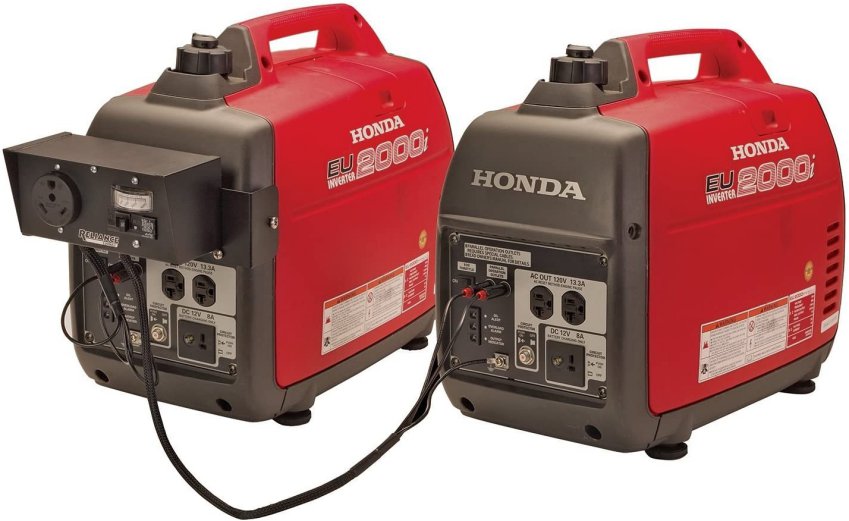
Sometimes, the need may arise to get the higher power output. Also, you can’t get a larger generator because you don’t always need that much power and want your generator to be much more portable. The solution to this problem is to increase or double the power output by connecting two portable generators through a kit or cables.
The paralleling gets simple when those two generators are from the same manufacturer and of the same power output. Moreover, it gets even more simple when the generators are parallel capable. You can connect different generators too, but the process will vary.
Can You Parallel Non-Inverter Generators?
The paralleling of two non-inverter generators is a complex and tricky process. But yes, it is possible, and with the right tools and proper knowledge, it can be done.
For parallel connection of any generators, their power output should match, the voltage and frequency should also match. If that is so, then they can be paralleled. The meaning of voltage and frequency matching is that the voltage waveform of both the generators should be in sync with each other.
The approach to performing the parallel connection of two non-parallel inverters is difficult and it may even damage both of the generators, and there are no chances of mistake. We strongly suggest that if you don’t know what you are doing, then refrain from doing this.
Can You Parallel Two Different Size Generators?
Yes, you can parallel two generators of different sizes. The basic condition for a parallel connection that needs to be fulfilled is the same voltage level and the same frequency output. If they are parallel capable, then you can simply use the parallel kit to make the connection. A kit will automatically balance the load connected.
It would be best if both the generators are inverter type because they can communicate with each other hence their output voltage and frequency will be the same.
But if the generators are not parallel capable, then they can also be connected in parallel using the parallel cable. Also, if there is no parallel kit available for both different size generators then you can use the parallel cables.
But, the connection needs to be done with some care. They should be compatible with the interface, which means they should be able to communicate with each other. If it is not, or some parts in them are not compatible, then it may damage the generators.
https://www.youtube.com/watch?v=bsu3C15WNhE
Can You Parallel Two Different Brand Inverter Generators?
As long as the voltage and frequency at the point of connection from both the generators stay the same, they can be connected in parallel, and it doesn’t matter if they are from different brands. As mentioned, the parallel connection gets much easier if they both are parallel capable and of the same size.
Now, consider this, if one of them is parallel capable and one of them is not. Then still, you can connect them in parallel. First, connect the output cable of the non-parallel capable generator to the input of the parallel capable generator. Connect your appliances to the second generator and start the non-parallel capable generator and then the second one.
Now suppose, both the different brand generators have different outlet plug. In that condition, try to convert one outlet to another one and then use the parallel cables. For example, if the first generator has an L5-30 outlet with a round plug, while the other has an L5-30 outlet with a square design. Then by modifying any one of the outlets to another one, you can make a successful parallel connection between two different brand inverter generators.
Can You Run Three Generators in Parallel?
Yes, you can. But all three generators should be of inverter type. For successful parallel connection of three generators, connect the two generators to parallel kit and also connect the third generator’s output to the parallel kit and you are good to go.
But if the generators are of non-inverter type then don’t attempt this procedure at all. It may damage your generators and your appliances too. In industrial generators, this procedure is done by matching the phase sequence, phase angle, and waveform and it is done by professionals.
Does paralleling cause damage to your generator?
A paralleling of generators will not cause any damage if you have used cables of the proper gauge and properly followed the precautions and instructions provided in the instructions manual from manufacturers. The risk of damaging generators was high in past years when very few generators came with the parallel capability.
But, nowadays, almost every inverter generator is parallel capable. Also note that when one of the two parallel generators gets overload, it will simply shut off so there won’t be any damage.
How to wire two generators in parallel?
The first step to make a parallel connection between two generators is to check whether they are parallel capable or not. If they are, then your job becomes extremely easy. If not, then the process is complicated, the solution to different possibilities and how to connect different generators we have already discussed.
When generators are parallel capable, you can connect them directly to the parallel kit, and it is done. The power from the generators will be automatically adjusted depending on the load connected. To make a connection, you will need to use an extension cord of the proper gauge.
Coming to the parallel kit, it will have a total of six outlets, from which four are power outlets to connect the generators, and two are ground outlets. The connection is simple, but you will need to go through the instructions manual and read all the instructions and precautions carefully to make a safe connection.
If you find that your generator has a plus and minus sign on the parallel connection port, then to make the right connection, you will need to refer to the parallel kit reference manual. Once it is done, connect the ground wires between the generator and ground ports. That’s it, your generators are connected in parallel and can now power the appliances.
Why running generators in parallel is better than buying one big generator?
To power many demanding appliances at once, you have two options, first, buy a large portable generator, and the second, connect two generators in parallel with each other to increase their power output.
Small generators can power only a few essentials during the power outage, but if you want to power many other appliances, then a better solution is a parallel connection of generators rather than one big one. It has many benefits.
Suppose you already have a generator which can’t power all the appliances you want it to power; here, to buy another same size generator and connect in parallel will be a good idea rather than one big generator. A bigger generator will cost you more, and on top of that, you will have less use of it due to its bigger size and weight.
Another benefit is the flexibility they offer. They are two separate generators and can be used as individuals when less power is needed. Two generators mean small size and weight, which ensures the increased portability.
You can bring them along on a camping trip or power an RV, or at a job site to run your power tools. They can be transported very easily compared to the big generators. Moreover, the parallel connection is very easy. You just need to connect them to the parallel kit, and it is done.
If you have two generators, then the failure of one won’t cause all the appliances to stop. Critical loads can be powered from the other one. As most of the large generators in the market are open-frame generators, you can’t power your sensitive electronics without worry-free because the power may not be clean and can damage the electronics. But, two parallel inverter generators will provide clean power, which is safe for electronics.
What is synchronization, and why is it important for a successful parallel connection?
For a successful and safe connection of two generators in parallel, some parameter needs to be matched. These parameters are voltage, frequency, phase angle, and phase sequence. The process of matching these parameters is known as synchronization.
In simple terms, electricity flow is regarded as a sine wave. So, the synchronization is the perfect matching between sine waves of two or more generators to be connected in parallel.
If generators are not synchronized, then it will damage the appliances and the generator itself. So, synchronization is a must. Most of the modern generators can automatically synchronize themselves when connected to the parallel kit. The generators are said to be properly synchronized when their phase sequence, frequency, and voltage peaks are matched.
You won’t get a safe and stable power unless they are not properly synchronized.

